When it comes to beef ribs, there’s more than just one type to choose from. Depending on the cut and location of the meat, different types of beef ribs can offer a variety of flavors and textures. Whether you prefer a more tender and juicy meat or a chewier, more flavorful one, there’s a type of beef rib for everyone. Some of the most popular styles include the short ribs, the back ribs, and the ribeye roast. Each cut is unique and can be prepared in various cooking methods, such as grilling, smoking, or braising. In this article, we’ll explore the different types of beef ribs and how to cook them to perfection.
What Are Beef Ribs?
Beef ribs are, as the name suggests, ribs from a cow. They can come from different parts of the animal, but the most common cuts are short ribs and back ribs. Short ribs come from the lower part of the cow’s ribcage, while back ribs come from the upper part of the ribcage near the spine.
Short ribs are usually larger and meatier than back ribs, but both cuts are delicious and can be used in various dishes. Short ribs are often braised, while back ribs are smoked or grilled.
Types of Beef Ribs?
When it comes to beef ribs, there are different types to choose from. The most popular ones are the short ribs and the back ribs. Short ribs come from the lower portion of the cow’s chest area and have a lot of meat on them. They can be slow-cooked or grilled and are known for their rich, flavorful taste. On the other hand, back ribs come from the upper portion of the cow’s ribcage and are commonly known as “baby back ribs.” They have less meat than short ribs but are still delicious when grilled or smoked.
There are different types of beef ribs, each with its unique flavor and texture. Now, we will explore the different types of beef ribs that you can find at your local butcher or grocery store.
Short Ribs
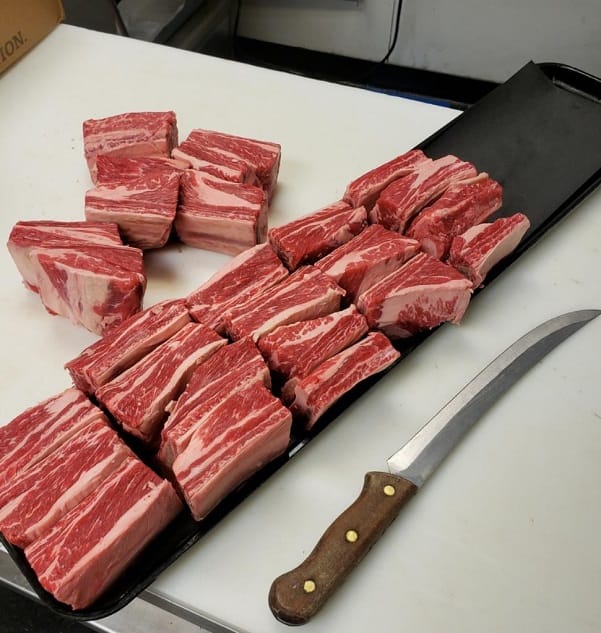
Short ribs are one of the most popular types of beef ribs. They come from the lower portion of the cow’s ribcage and are usually cut into short sections, hence the name. Short ribs are typically sold bone-in, and the meat is rich and flavorful with a good amount of marbling. They are perfect for slow-cooking methods like braising, smoking, or roasting, making the meat tender and juicy.
Back Ribs
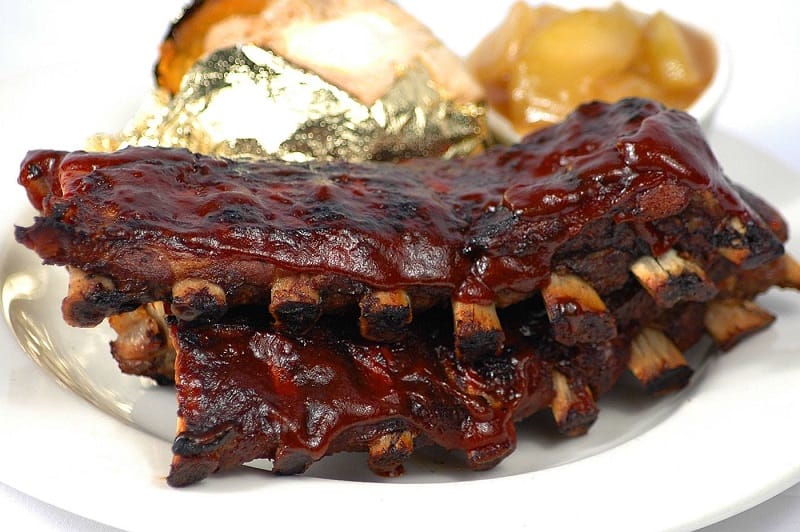
Back ribs, also known as baby back ribs, are taken from the upper part of the cow’s ribcage. They are shorter and more curved than short ribs, and the meat is leaner with less marbling. Back ribs are a great option for grilling, and they are often coated with a dry rub or barbecue sauce to enhance their flavor.
Plate Short Ribs
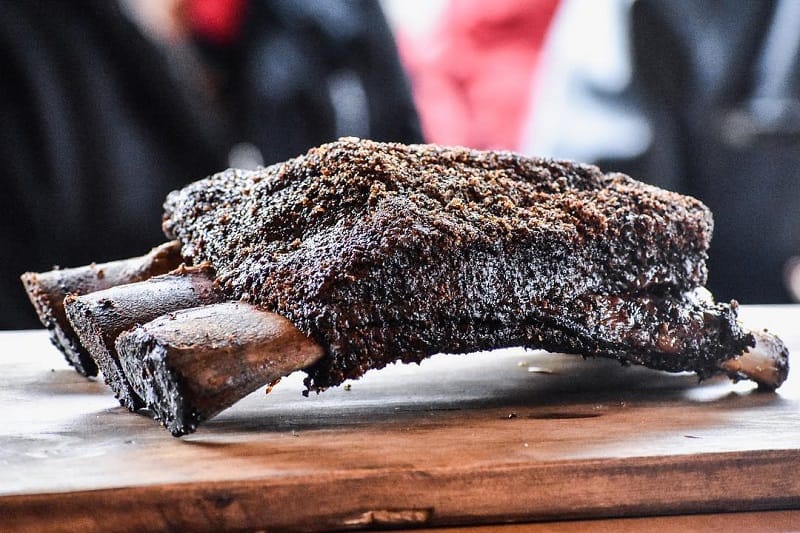
Plate short ribs are cut from the lower portion of the cow’s ribcage, just below the short ribs. They are a bit thicker than short ribs and are sold bone-in. Plate short ribs are known for their rich, beefy flavor and are perfect for slow-cooking methods like braising or roasting.
Chuck Ribs
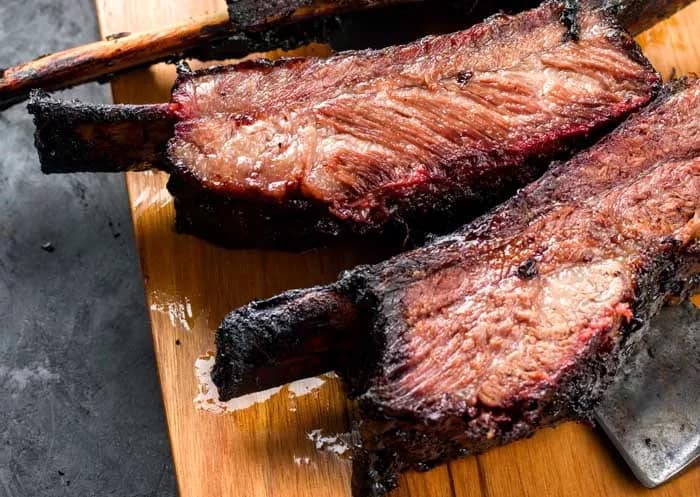
Chuck ribs are taken from the shoulder area of the cow and are less common than other types of beef ribs. They are sold bone-in and have a meaty, flavorful taste. Chuck’s ribs are great for slow-cooking methods like braising or smoking and can also be grilled or roasted.
Flanken Ribs
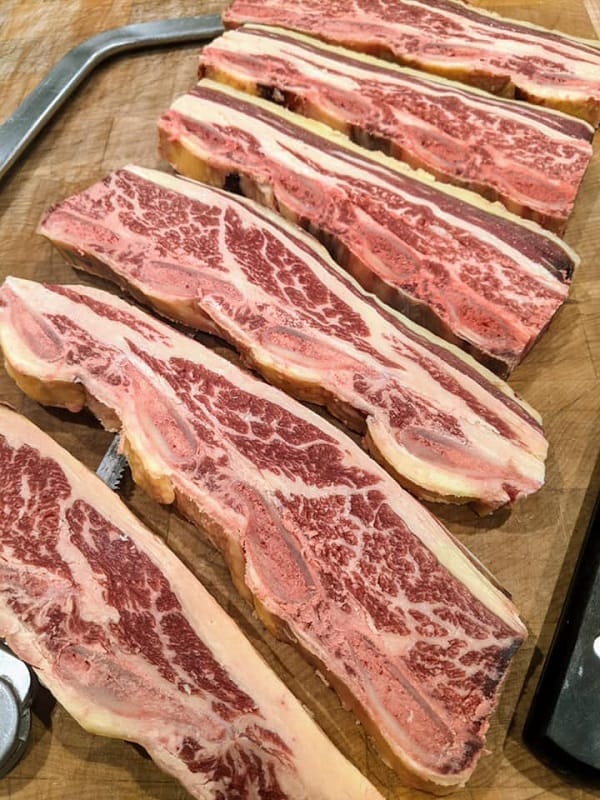
Flanken ribs, also known as Korean-style short ribs, are cut across the bone instead of between the bones. They are thinner and have a strip of meat attached to each bone. Flanken ribs are perfect for grilling or pan-frying. They have a slightly sweet flavor and a chewy texture. They are also great for marinades, which help to tenderize the meat.
English Cut
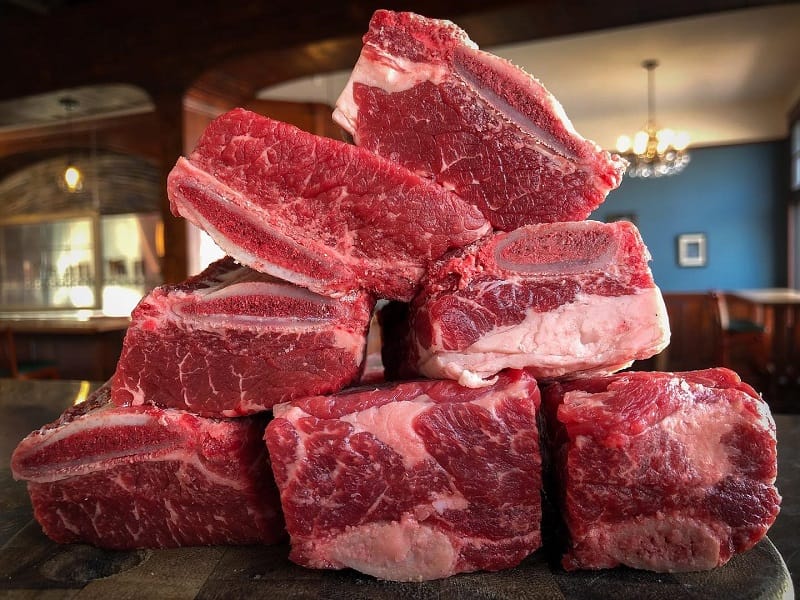
English cut ribs, also known as plate ribs, are cut from the lower part of the cow’s ribcage. They are meatier than other ribs and have a rich, beefy flavor. English-cut ribs are perfect for smoking, braising, or roasting. They have a good amount of fat, which makes them juicy and tender when cooked low and slow.
Riblets
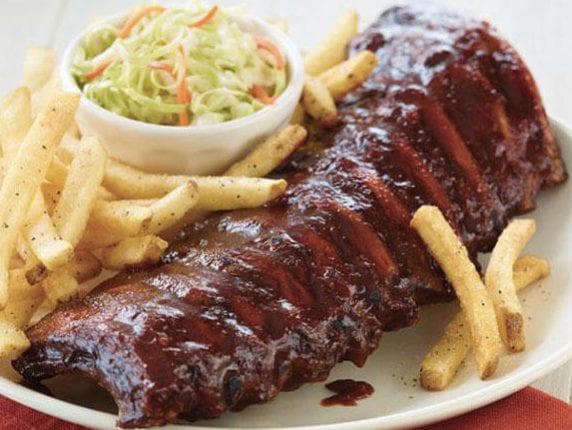
Riblets are small, bite-sized portions of beef ribs. They come from the same part of the cow as baby back ribs but are smaller and have less meat. Riblets are perfect for grilling or broiling. They have a rich, beefy flavor and a chewy texture. They are also great for marinades, which help to tenderize the meat.
No matter which type of beef ribs is chosen, they provide an indulgent and flavorful dining experience. From tender short ribs to juicy back ribs, beef ribs are the perfect way to enjoy a delicious and satisfying meal, whether preparing them in a slow cooker or on a grill.
Read more:
What Is The Best Cut Of Beef For Ribs?
First up, we have beef short ribs. This cut comes from the lower portion of the animal’s ribs and is known for its rich, meaty flavor. Beef short ribs are a popular choice for slow-cooking methods like braising or smoking, as they have a high-fat content that helps keep them moist and tender. However, they can be tough if not cooked properly, so give them plenty of time to cook slowly.
Next, we have beef back ribs. This cut comes from the upper portion of the animal’s ribs and is smaller and leaner than beef short ribs. Beef back ribs are often grilled or smoked and are known for their meaty flavor and tender texture. However, they are leaner than beef short ribs, so they can dry out quickly if overcooked. To prevent this, keep a close eye on them and remove them from the heat as soon as they’re done.
Another popular cut for beef ribs is the beef ribeye roast. This cut comes from the same portion of the animal as the beef prime rib roast and is known for its rich, beefy flavor and tender texture. Beef ribeye roasts can be grilled or roasted and are a great choice for special occasions or holidays. However, they can be quite expensive, so they may not be the best choice if you’re on a budget.
Last but not least, we have beef brisket. This cut comes from the breast portion of the animal and is known for its tough, chewy texture. However, beef brisket can become incredibly tender and flavorful when cooked low and slow. Brisket is a popular choice for smoking and is often used to make Texas-style barbecue. It can be tricky to cook, but with patience and practice, anyone can master the art of cooking a perfect brisket.
So which cut of beef is the best for ribs? Ultimately, it depends on your preference and what type of cooking method you’ll use. If you plan to slow-cook your ribs, beef short ribs or beef brisket are great choices. If you plan to grill or smoke them, beef back ribs or beef ribeye roast are the way to go. Whichever cut you choose, give it plenty of time and attention to ensure it comes out deliciously tender and flavorful.
What Are The Best Beef Ribs For Barbecue?
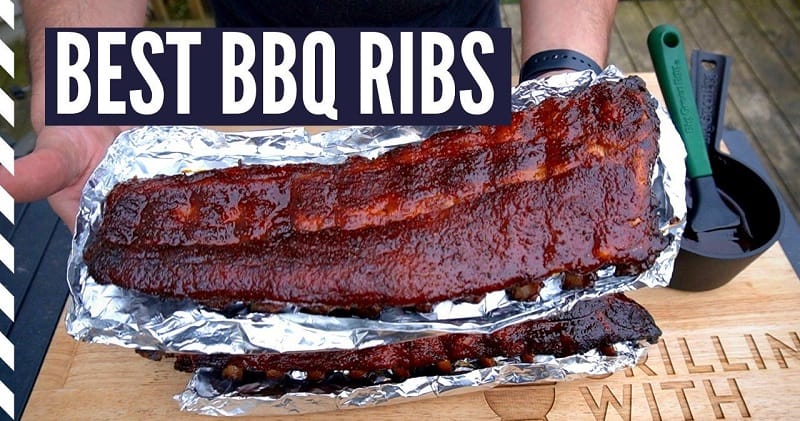
Beef ribs are cut from the cow’s rib section and can be divided into short ribs and back ribs. Short ribs are cut from the lower portion of the rib section and are typically sold in thick, meaty slabs. On the other hand, back ribs are cut from the upper part of the rib section and are longer and more slender. Both ribs can be delicious when cooked correctly, but the ideal cut depends on your taste preferences and cooking style.
- Short Ribs: Short ribs are popular for barbecue enthusiasts because of their rich flavor and tender texture. When cooked low and slow, this cut can be melt-in-your-mouth tender. There are two types of short ribs: English cut and flanken cut. English short ribs are cut parallel to the bone and have a meaty, bone-in section. Flanken cut short ribs are cut across the bone and have a thin layer of meat on top of the bone. Flanken-cut ribs are perfect for grilling, while English-cut ribs are best suited for slow-cooking methods like smoking or braising.
- Back Ribs: Back ribs, also known as baby back ribs, are a popular choice for a barbecue because of their tender, meaty texture. These ribs are cut from the upper portion of the rib section and are smaller and more slender than short ribs. Back ribs are an excellent option for grilling or smoking and are often cooked with a sweet and tangy barbecue sauce.
So, when it comes to choosing the best beef ribs for barbecue, it’s all about personal preference. Short ribs are a great option for those who prefer a rich, meaty flavor and tender texture, while back ribs are ideal for those who prefer a sweet and tangy flavor profile. No matter which cut you choose, be sure to select high-quality meat, prepare it correctly, and take your time to enjoy the delicious, slow-cooked flavors of perfectly barbecued beef ribs.
What Are The Best Beef Ribs For Braising?
Before we dive in, let’s quickly go over what braising is. Braising is a cooking technique that involves searing the meat first, then cooking it in liquid (often wine or broth) on low heat for an extended period. This method is perfect for tough cuts of meat, as the low-and-slow cooking process breaks down the connective tissue and turns the meat into tender, juicy perfection.
When braising beef ribs, choosing the right cut of meat is key. Short ribs, beef back ribs, and chuck ribs are all excellent choices, with plenty of flavor and tenderness when cooked low and slow.
- Short Ribs: Short ribs are one of the most popular cuts of beef ribs for braising, and for a good reason. They are well-marbled and have a good amount of fat and collagen, which makes them perfect for slow cooking. When braised, short ribs become incredibly tender and flavorful, with a rich and savory taste that is hard to resist.
- Beef Back Ribs: Beef back ribs are another great cut of meat for braising, with a meaty texture and plenty of flavors. These ribs come from the upper part of the cow’s ribcage and are usually sold in 3-4 ribs racks. When braised, beef back ribs become tender and juicy, with a rich, beefy taste that is hard to beat.
- Chuck Ribs: Chuck’s ribs are another excellent choice for braising, with a rich and meaty taste that is hard to resist. These ribs come from the cow’s shoulder, are well-marbled, and have plenty of connective tissue, making them perfect for slow cooking. When braised, chuck ribs become incredibly tender and flavorful, with a savory taste that is sure to please.
Whether you’re making a hearty stew, a rich and savory sauce, or a simple pot roast, these beef ribs will surely impress.
How Do Short Ribs Differ From Back Ribs?
First, let’s start with the basics. Both short ribs and back ribs come from the same animal, typically pork or beef. However, they differ in their location on the animal and how they are cut.
Short ribs come from the lower portion of the animal’s rib cage and are typically cut into 2-4 inch lengths. They contain a significant amount of meat, fat, and connective tissue, which gives them a rich, beefy flavor and a moist and tender texture when cooked correctly.
On the other hand, the back ribs come from the upper portion of the animal’s rib cage, just below the spine. They are longer and leaner than short ribs, with less meat and more bone. Back ribs are typically cut into individual portions and are known for their signature curved shape.
When it comes to cooking, short ribs, and back ribs require different methods to achieve the best results. Short ribs are best when braised or slow-cooked, which helps to break down the tough connective tissue and create tender and flavorful meat. They can be cooked in a Dutch oven, slow cooker, or pressure cooker and are often served with a rich sauce or gravy.
Back ribs, on the other hand, are best when grilled or smoked. They have a natural sweetness and a slightly smoky flavor that pairs perfectly with a dry rub or BBQ sauce. Back ribs should be cooked low and slow over indirect heat to achieve the perfect texture and finished with a high-heat sear.
In terms of flavor, short and back ribs have unique characteristics that make them stand out. Short ribs have a rich, beefy flavor that pairs well with bold seasonings and sauces. They also have a melt-in-your-mouth texture that is hard to beat. Back ribs have a sweet and smoky flavor that is enhanced by grilling or smoking. They are also leaner than short ribs, making them a good choice for those who prefer lighter meat.
So, which one should you choose? It ultimately comes down to personal preference and how you plan to cook them. Short ribs are the way to go if you’re looking for hearty and flavorful meat that can be slow-cooked to perfection. If you prefer a leaner cut of meat with a sweet and smoky flavor, back ribs are your best bet.
What Are The Nutritional Benefits Of Beef Ribs?
Beef ribs are a delicious and satisfying meal that many people enjoy. However, not many people know about the nutritional benefits of eating beef ribs. We will explore the nutritional value of beef ribs and how they can contribute to a healthy diet.
- Protein Powerhouse: Beef ribs are a great source of protein. Protein is an essential nutrient needed for building and repairing tissues in the body. It is also necessary to produce enzymes, hormones, and other body chemicals. A serving of beef ribs can provide up to 20 grams of protein, making it an excellent choice for anyone looking to increase their protein intake.
- Vitamins & Minerals: Beef ribs are also packed with essential vitamins and minerals. They are an excellent source of iron, zinc, and vitamin B12. Iron is essential for producing red blood cells, while zinc is vital in immune function and wound healing. Vitamin B12 is essential for the nervous system and the production of DNA.
- Healthy Fats: Beef ribs also contain healthy fats essential for overall health. The fats in beef ribs are primarily unsaturated, which is good for the heart. These fats can help lower cholesterol levels and reduce the risk of heart disease. Additionally, these fats are also essential for brain function and hormone production.
- Boosts Immune System: Beef ribs contain selenium, an essential mineral that helps boost the immune system. It is also a potent antioxidant that helps to protect the body from oxidative stress. Selenium has also been linked to a reduced risk of certain types of cancer.
- Energy Booster: Beef ribs are also an excellent source of energy. They are high in calories, making them perfect for anyone looking to increase their energy levels. Additionally, beef ribs contain carbohydrates that give the body the energy needed for physical activity.
Beef ribs offer a range of nutritional benefits that can contribute to a healthy diet. They are a great source of protein, vitamins, and minerals and contain healthy fats essential for overall health. Additionally, they can help to boost the immune system, increase energy levels, and reduce the risk of heart disease and certain types of cancer. So, next time you’re enjoying a plate of beef ribs, remember that they are delicious and incredibly nutritious.
How Can Beef Ribs Be Stored To Maintain Quality And Freshness?
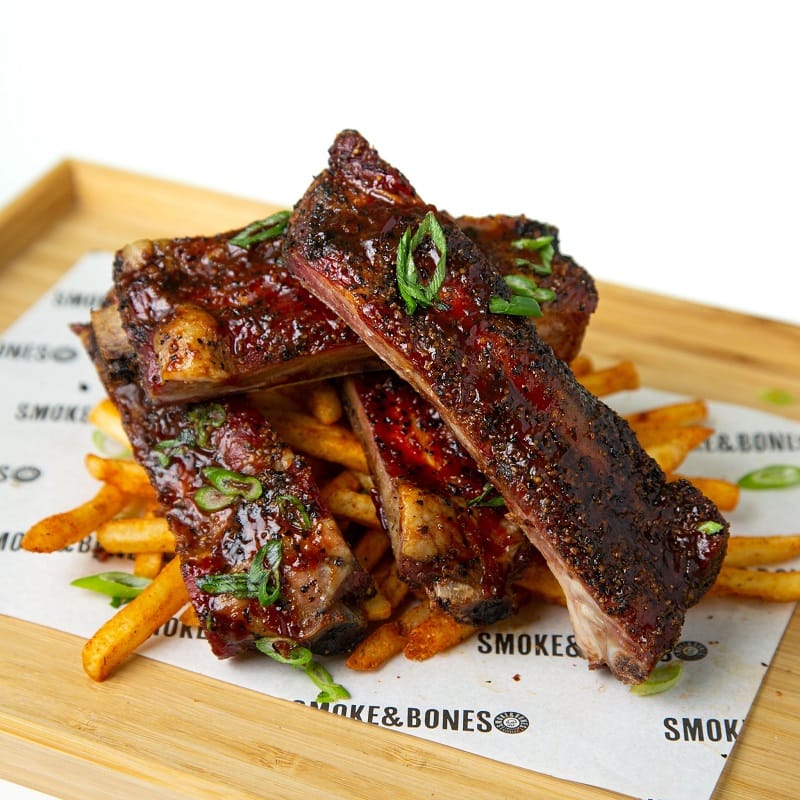
Maintaining the quality and freshness of beef ribs can be a challenging task. We will discuss the various methods that can be used to store beef ribs and keep them fresh for longer periods.
1. Refrigeration
- Refrigeration is one of the most common methods used to store beef ribs. However, it is essential to note that not all ribs are the same. Beef ribs can be short or back ribs, the most common being back ribs.
- It is recommended to store beef ribs in the refrigerator for no longer than three to four days. If you plan to keep them longer, freezing is the best option.
2. Freezing
- Freezing is an excellent way to store beef ribs for long periods. Before freezing, make sure that the ribs are properly wrapped. Wrap them in plastic wrap, aluminum foil, or butcher paper. This helps to prevent moisture loss and freezer burn.
- Beef ribs can be stored in the freezer for up to six months. However, it is important to note that the longer they are stored, the more the quality and flavor will be compromised.
3. Vacuum Sealing
- Vacuum sealing is another method that can be used to store beef ribs. This method helps to remove the air from the packaging, which helps to prevent freezer burn and moisture loss. Vacuum sealing also helps retain the ribs’ original flavors and textures.
- Beef ribs can be stored in a vacuum-sealed bag for up to two years. This method is ideal if you plan to store the ribs for a long.
4. Sous Vide Cooking
- Sous vide cooking is a method that involves cooking food in a vacuum-sealed bag at a precisely controlled temperature. This method helps to retain the moisture and flavors of the food.
- Sous vide cooking is an excellent way to cook beef ribs perfectly and retain their freshness and quality.
How Do You Select The Best Beef Ribs For Cooking?
Selecting the best beef ribs for cooking can be daunting, especially if you’re new to the meat game. We’ll share some tips on choosing the best beef ribs for your next cookout.
- Choose the Right Cut: The cut is the first thing you must consider when selecting beef ribs. There are two main types of beef ribs – back and short. The back ribs come from the upper part of the ribcage, while the short ribs come from the lower part. Back ribs are leaner and have less meat than short ribs, which are more tender and fatty. If you’re looking for a leaner cut, back ribs are the way to go. But if you want a more succulent and flavorful cut, then short ribs are the way to go.
- Look for Marbling: The second thing you need to consider is the marbling. Marbling refers to the flecks of fat found throughout the meat. The more marbling a cut has, the more tender and flavorful it will be. Look for beef ribs that have visible marbling. The meat may not be as flavorful or tender if it looks too lean.
- Consider the Grade: The third thing you need to consider when selecting beef ribs is the grade. Beef is graded based on its quality and marbling. The three main grades are prime, choice, and select. Prime is the highest grade and has the most marbling, while select is the lowest grade and has the least marbling. If you want the best quality beef ribs, look for prime or choice cuts. However, select cuts can still be great for slow cooking.
- Check the Color: The fourth thing you need to consider when selecting beef ribs is the color. The meat should be deep red, and the fat should be creamy white. If the meat looks brown or gray, it may not be fresh. Also, avoid beef ribs that have a lot of connective tissue or are discolored. This could be a sign of poor quality or mishandling.
- Consider the Source: The fifth thing you need to consider when selecting beef ribs is the source. Look for beef that is raised without antibiotics or hormones. Grass-fed beef is also a great option, as it tends to be leaner and has a more robust flavor. Local beef is also a great option, as it’s usually fresher and supports local farmers.
Common Mistakes People Make When Cooking Beef Ribs
Cooking beef ribs can be a bit tricky, and there are a few common mistakes that people make when cooking them. Now, we will discuss common mistakes people make when cooking beef ribs and how to avoid them.
Mistake #1: Not Prepping the Ribs
- One of the most common mistakes people make when cooking beef ribs is not prepping them properly. The first step to preparing beef ribs is to remove the membrane covering the ribs’ bone side. This membrane can be tough and chewy, preventing the flavor from penetrating the meat. To remove the membrane, use a sharp knife to loosen a corner of the membrane, then use a paper towel to grip it and peel it off.
- Another important step in prepping beef ribs is to season them properly. Seasoning is key to bringing out the flavor of the meat. Be sure to use a rub with salt, pepper, garlic powder, onion powder, and any other seasonings you prefer.
Mistake #2: Cooking at the Wrong Temperature
- Beef ribs are best cooked low and slow. This means cooking them at a low temperature for a long period. The ideal temperature for cooking beef ribs is between 225-250°F. Cooking them at a higher temperature may cause the meat to become tough and dry.
Mistake #3: Not Using a Thermometer
- Another common mistake people make when cooking beef ribs is not using a thermometer. This is important because it ensures the meat is cooked to the correct temperature. The ideal temperature for beef ribs is 203°F. This temperature ensures that the meat is tender and flavorful.
Mistake #4: Not Letting the Meat Rest
- After cooking beef ribs, it is important to let them rest for at least 10-15 minutes before slicing. This allows the juices to redistribute, making the meat more tender and juicy.
Mistake #5: Not Using the Right Sauce
- The right sauce can make or break your beef ribs. There are many different sauces, but the most popular are barbecue sauce and dry rub. If you use barbecue sauce, brush it on during the last 20-30 minutes of cooking. This will give the sauce time to caramelize and create a delicious crust on the meat.
How Do You Know When Beef Ribs Are Fully Cooked, And What Internal Temperatures Should You Aim For?
Beef ribs are a delicious and hearty dish that can be cooked in various ways. Whether you are planning on grilling, smoking, or braising your beef ribs, knowing when they are fully cooked is essential to achieve the best taste and texture. So, how do you know when beef ribs are fully cooked, and what internal temperatures should you aim for?
Internal Temperatures to Aim For
The internal temperature of your beef ribs is the most important factor to consider when determining if they are fully cooked. The temperature you should aim for depends on your chosen cooking method. Here are the recommended internal temperatures for beef ribs based on the cooking method:
- Grilled Beef Ribs: If you are grilling your beef ribs, aim for an internal temperature of 145°F to 160°F. This temperature range will give you medium to medium-well beef ribs.
- Smoked Beef Ribs: For smoked beef ribs, aim for an internal temperature of 190°F to 203°F. This temperature range will give you tender and flavorful beef ribs.
- Braised Beef Ribs: If you are braising your beef ribs, aim for an internal temperature of 160°F to 170°F. This temperature range will give you tender and juicy beef ribs.
How to Test the Internal Temperature of Your Beef Ribs
Now that you know the recommended internal temperatures for beef ribs, the next step is to learn how to test the temperature of your beef ribs. You can use two methods to test the internal temperature of your beef ribs: a meat thermometer or a poke test.
- Meat Thermometer: The most accurate way to test the internal temperature of your beef ribs is to use a meat thermometer. Insert the meat thermometer into the thickest part of the meat, ensuring not to touch any bones. Wait a few seconds for the temperature to stabilize, and then read the temperature on the thermometer.
- Poke Test: If you don’t have a meat thermometer, you can use a poke test to check the doneness of your beef ribs. Using a fork or a knife, poke the meat and observe the color of the juices. If the juices are clear, your beef ribs are cooked. Your beef ribs need more cooking time if the juices are pink or red.
Signs That Your Beef Ribs Are Fully Cooked
In addition to the internal temperature, there are a few signs you can look for to determine if your beef ribs are fully cooked. Here are some signs to look for:
- Bone Separation: When beef ribs are fully cooked, the meat should easily pull away from the bone. If you have to use a lot of force to separate the meat from the bone, your beef ribs are not fully cooked.
- Tenderness: Fully cooked beef ribs should be tender and juicy. If your beef ribs are tough or dry, they need more cooking time.
- Color: The color of your beef ribs should be brown and caramelized on the outside and pink or red on the inside. If your beef ribs are gray, they are overcooked.
FAQs
What’s The Difference Between Beef And Pork Ribs?
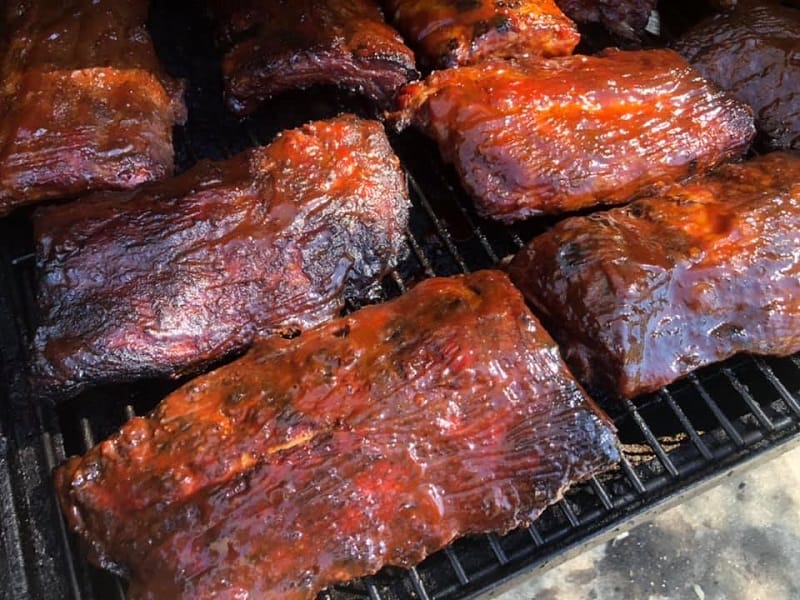
While they may look similar at first glance, the two have some fundamental differences. The most striking difference is their size – beef ribs are noticeably bigger than pork ribs. Beef ribs also come in two cuts – back ribs and short ribs – whereas pork ribs are usually smaller and have a smaller bone-to-meat ratio.
Another key difference is the taste. Beef ribs have a specific and stronger taste than pork beef. Additionally, beef ribs are fattier than pork ribs, with closer to even portions of meat and fat.
See: https://tiredtexanbbq.com/blog/beef-vs-pork-ribs/
What Are Some Common Seasonings For Beef Ribs?
One of the best ways to enhance the delicious taste of beef ribs is by using a variety of common seasonings readily available in most kitchens. Some of the most common seasonings for beef ribs include paprika, chili powder, brown sugar, black pepper, garlic powder, and salt. These ingredients can be mixed to create a dry rub, which is rubbed onto the beef ribs’ surface.
Coarse salt is another important ingredient to use in a rib rub recipe. By infusing the meat with these flavorful seasonings, beef ribs will surely be a hit at any gathering.
What Are The Most Popular Sides To Serve With Beef Ribs?
There are plenty of options to choose from. Top choices include milk and butter boiled corn on the cob, macaroni and tomatoes, boiled potatoes, wedge salad, creamed corn, vinegar coleslaw, cucumber tomato salad, slow-cooker collard greens, crockpot baked beans, mashed potatoes, and polenta. Each of these sides brings its unique and delicious flavor profile to the table, making it the perfect complement to a plate of beef ribs.
What Wines Pair Well With Beef Ribs
When it comes to enjoying beef ribs, choosing the right wine to enhance the meal’s flavor is important. Red wines are often the go-to choice due to their full-bodied nature, with favorites including Chianti, Châteauneuf-du-Pape, Syrah, Petite Syrah, Pinotage, and Cabernet Sauvignon.
Try Gamay, Pinot Noir, or Grenache for something different. It is also worth considering the region the wine comes from, with Sangiovese from Tuscan subregions and Syrah from Sonoma Coast or Northern Rhone being excellent options. Don’t forget to consider the vintage, with the 2008 Fiddletown Cellars Old Vine Zinfandel from Amador County being a fantastic choice.
Why Are Beef Ribs So Popular In Texas-Style BBQ?
Beef ribs are an essential part of Texas-style barbecue, and for a good reason. Pitmasters in Texas use beef ribs to showcase their skills and create mouthwatering dishes that people can’t resist.
The state’s ranching tradition means that beef is widely available, making it a natural choice for barbecue. Central Texas barbecue, known for its smoky flavor, features meat that is slow-cooked to perfection.
While pork ribs and sausages are famous, beef ribs have become a true showstopper. These ribs, often 6 to 8 inches long with a curved bone, are perfect for braising or cooking on the grill over indirect heat. They’re often seasoned with beef rib rub, making them juicy, flavorful, and irresistible.
With a history dating back to Louie Mueller Barbecue and the famous beef short ribs, it’s no surprise that beef ribs remain a staple of Texas-style barbecue today.
Types of Beef Ribs – Conclusion
In conclusion, whether you’re a fan of beef back ribs, beef short ribs, or any other types of beef ribs, there’s no denying that these cuts of meat are a delicious and satisfying meal. So, the next time you’re at the grocery store or the butcher shop, try some of the different beef ribs available and experiment with different cooking methods to find your favorite. And don’t forget, always choose high-quality meat to ensure the best taste and health benefits.
References:
- https://www.platingsandpairings.com/35-easy-sides-for-ribs-what-to-serve-with-bbq-ribs/
- https://www.yummly.com/recipes/dry-rub-beef-ribs
- https://www.foodandwine.com/wine/3-terrific-wines-pair-short-ribs

Hey readers! Chip Holland here, and I’m a Manager of this website. My passion for writing about it only matches my passion for BBQ. Follow my blog for mouth-watering recipes, tips, and tricks for the perfect smoke, grill, and BBQ. I’m sure you won’t be disappointed!
